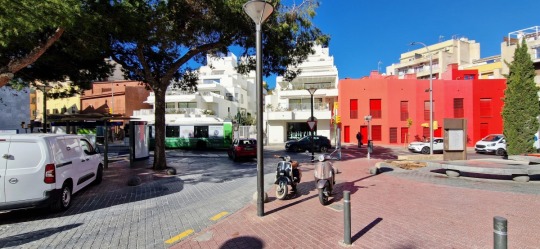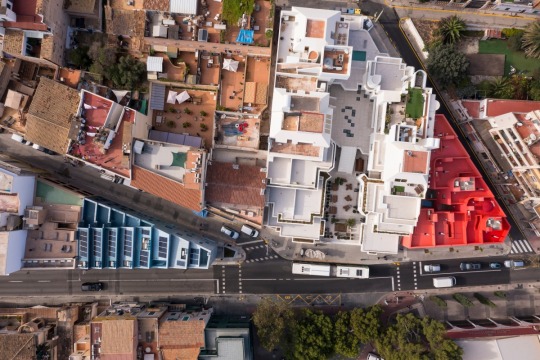#Gomila
Explore tagged Tumblr posts
Text
#Campe#El Terreno#Gomila#La movida#Lorenzo Santamaría#Palma#Raphael#Ricky López#Tito's#Xavier#Abrahamm#ítico#ocio nocturno#ultima hora#Itziar F. Landero#Palma21/04/24 0:30#2024#202404#20240421
0 notes
Text
tumblr doesnt have that much drama anymore which is understandable but HOLY SHIT gosupermodel is full of it.
#the mistreatment from management.... the volunteers not given a timeframe to come back....#THE WHOLE GOMILA SITUATION. (JUSTICE FOR GOMILA BTW)#its actually fucking insane i need to make a video essay on this
5 notes
·
View notes
Text

Carles Gomila “Third Eye”, Ink on genuine 18th century paper 16″ x 12″
2 notes
·
View notes
Text
Form Follows Footwear
[Originally published in the April 2024 Mediterranean issue of The Architectural Review] Plaza Gomila, a small urban square in Palma on the Mediterranean island of Mallorca, was the epicentre of the city’s glamorous nightlife in the 1970s, but fell into urban decline in the 1990s. At the heart of El Terreno, a neighbourhood rising uphill from Palma’s harbour below a majestic castle, Plaza Gomila…

View On WordPress
0 notes
Text
0 notes
Text

“The Sphinx-riddle. Solve it, or be torn to bits, is the decree.” — D. H. Lawrence
Sphinx Carles Gomila
405 notes
·
View notes
Text
I onda shvatiš da ti ne smeta gomila ljudi, gužva u saobraćaju, kiša...
Smeti ono što je u tebi i pored tebe.
121 notes
·
View notes
Text

"Third Eye" [Ink on geniun 18th century paper, art by Carles Gomila
18 notes
·
View notes
Text
jeste sve je to lepo ali rekla bih da rečnik srpskog jezika matice srpske ima malo veći autoritet nad rečima od zakona o osnovama bezbednosti saobraćaja na putevima

praćenje profila o pravopisu srpskog jezika na instagramu će biti moj trinaesti razlog. KAKO TO MISLIŠ ISPRAVNO JE I ŽMIGAVAC I MIGAVAC? PIŽAMA I PIDŽAMA? SVE ĆU VAM JEBATI PO SPISKU
#u zakonima postoji gomila fraza i izraza koji se “u narodu” kažu drugačije što ih ne čini neispravnim#ura.txt
7 notes
·
View notes
Text
U mojoj glavi se svađa gomila ljudi
Nadam se da se ne čuje
Dijete u meni još uvijek se čudi
Kamo sve to putuje
32 notes
·
View notes
Note
Mayonnaise (/ˌmeɪəˈneɪz/),[1] colloquially referred to as "mayo" (/ˈmeɪoʊ/),[2] is a thick, creamy sauce with a rich and tangy taste that is commonly used on sandwiches, hamburgers, composed salads, and French fries. It also forms the base for various other sauces, such as tartar sauce, fry sauce, remoulade, salsa golf, ranch dressing, and rouille.[3]
Mayonnaise is an emulsion of oil, egg yolk, and an acid, either vinegar or lemon juice;[4] there are many variants using additional flavorings. The color varies from near-white to pale yellow, and its texture from a light cream to a thick gel.
Commercial eggless versions are made for those who avoid chicken eggs because of egg allergies, to limit dietary cholesterol, or because they are vegetarian or vegan.
Mayonnaise is a French cuisine appellation that seems to have appeared for the first time in 1806. The hypotheses invoked over time as to the origin(s) of mayonnaise have been numerous and contradictory. Most hypotheses do however agree on the geographical origin of the sauce, Mahón, in Menorca, Spain.[6][7][8] Other theories have been dismissed by some authors as being somewhat a retrospective invention aiming to credit the sauce as an invention of south-western France, when most likely, its origin can be found in the port city of Menorca.[9]
According to Émile Littré, it may have come from Mahón, capital of Menorca, in the Balearic Islands, Spain, occupied by the British at the time and then conquered by the Duc de Richelieu in 1756. His cook would have presented him with this sauce, called the "mahonnaise", made with the only two ingredients he had: egg and oil. Nevertheless, this sauce was starting to be described a little before this event while several versions of similar sauces existed in France and in Spain.
Mayonnaise sauce may have its origins in the ancient remoulade. Another hypothesis is that mayonnaise is derived from aioli.[6] Finally, the process of emulsifying egg yolk was known for a long time to pharmacists, who used it to prepare ointments and salves. Some have pointed out that it would make sense that mayonnaise originated in Spain given its requirement of olive oil, a liquid produced and consumed mostly there at the time.[10] This hypothesis is similar to another that places the origins of French fries in Spain using the same rationale.[11][12][13]
Remoulade sauce was known for a long time and there were hot and cold versions of it. In both cases, the base was oil, vinegar, salt, herbs, often other ingredients such as capers or anchovies, and then mustard; in short, it was an enriched vinaigrette.[citation needed]
In the early 18th century, Vincent La Chapelle had the idea of incorporating "velouté", based on roux, a mixture of flour and fat, to bind it. In 1742, François Marin published in the Suite des Dons de Comus a recipe called "beurre de Provence" which contains garlic cloves cooked in water, crushed with salt, pepper, capers and anchovies, then mixed with oil. This recipe is also close to the aioli, the egg yolk appearing later.
In 1750, Francesc Roger Gomila, a Valencian friar, published a recipe for a sauce similar to mayonnaise in Art de la Cuina ('The Art of Cooking'). He calls the sauce aioli bo.[14] If he does not describe precisely the recipe—suggesting that it was known by everyone on the island—the way it is used, the preparations for which it is used as a base and the dishes with which it is associated are most often inconceivable with an aioli. Earlier recipes of similar emulsified sauces, usually containing garlic, appear in a number of Spanish recipe books dating back to the 14th-century Llibre de Sent Soví [es], where it is called all-i-oli, literally 'garlic and oil' in Catalan.[15][16] This sauce had clearly spread throughout the Crown of Aragon, for Juan de Altamiras gives a recipe for it in his celebrated 1745 recipe book Nuevo Arte de Cocina ('New Art of Cooking').[17]
On April 18, 1756, the Duke of Richelieu invaded Menorca and took the port of Mahon. A theory states that the aioli bo sauce was thereafter adopted by the cook of the Duke of Richelieu, who upon his return to France made the sauce famous in the French court.[18] which would have been known as mahonnaise .[19][20][21] A number of legends arose relating how the Duke of Richelieu first tried the sauce, including his discovery of the sauce in a local inn of Mahon where he would have allegedly asked the innkeeper to make him some dinner during the siege of Mahon,[22] and even that he invented it himself as a quick garnish.[20]
Another version is Grimod de La Reynière's 1808 bayonnaise sauce which is a sort of aspic: "But if one wants to make from this cold chicken, a dish of distinction, one composes a bayonnaise, whose green jelly, of a good consistency, forms the most worthy ornament of poultry and fish salads."[23][non-primary source needed]
In 1806, André Viard, in Le Cuisinier impérial, transformed this recipe for remoulade by replacing the roux with egg yolk.[24] In another recipe, an Indian remoulade, without mustard, he specifies that the binding is facilitated by incorporating the oil little by little. This is the first modern mention of a stable cold emulsified sauce.[25] In the same book, he also proposes a sauce called mayonnaise (the first recorded attestation of the name) but which is not an emulsion but a sauce linked to velouté and jelly.
It is only in 1815 that Antonin Carême mentions a cold "magnonaise" emulsified with egg yolk. The word "mayonnaise" is attested in English in 1815.[26]
Auguste Escoffier wrote that mayonnaise was a French mother sauce of cold sauces,[27] like espagnole or velouté.
(OOC: Copy and pasted from wikipedia✨)
……
well thank you for telling me?
5 notes
·
View notes
Text
MVRDV Makes a Difference
Photo by Jannes Linders courtesy MVRDV + GRAS [Originally published in DETAIL Magazine 5.2023] Project Gomila is a micro-urban reconstruction initiative by the owners of the Spanish global footwear brand Camper. When completed, it will provide 60 affordable housing units within seven highly differentiated mixed-use buildings in Palma de Mallorca’s eclectic but downtrodden El Terreno…

View On WordPress
0 notes
Text
0 notes
Text

“The Sphinx-riddle. Solve it, or be torn to bits, is the decree.” — D. H. Lawrence
Sphinx art by Carles Gomila
73 notes
·
View notes

